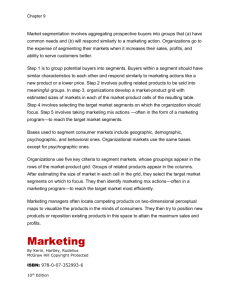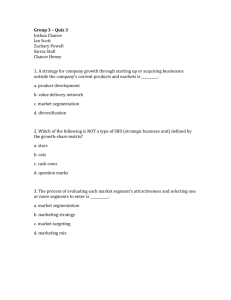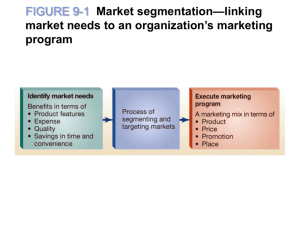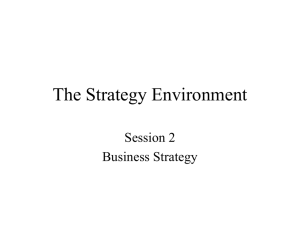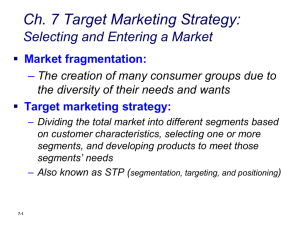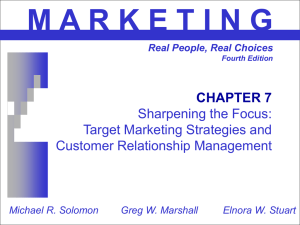lecture 10. segmenting, targeting, positioning.
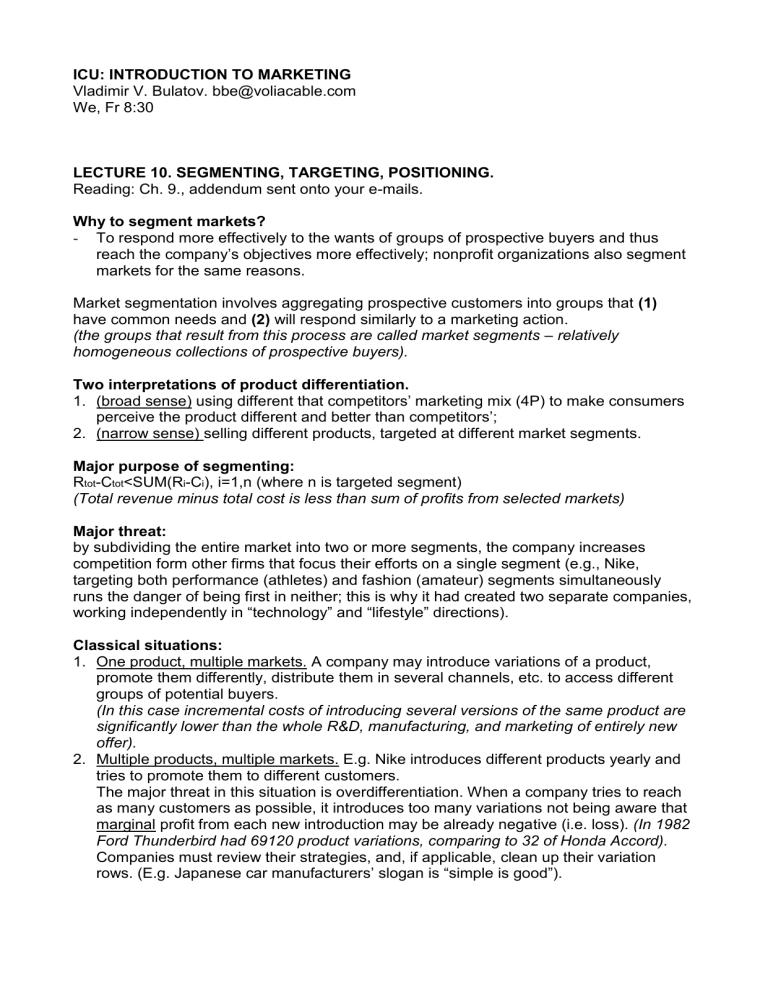
ICU: INTRODUCTION TO MARKETING
Vladimir V. Bulatov. bbe@voliacable.com
We, Fr 8:30
LECTURE 10. SEGMENTING, TARGETING, POSITIONING.
Reading: Ch. 9., addendum sent onto your e-mails.
Why to segment markets?
To respond more effectively to the wants of groups of prospective buyers and thus reach the company’s objectives more effectively; nonprofit organizations also segment markets for the same reasons.
Market segmentation involves aggregating prospective customers into groups that (1) have common needs and (2) will respond similarly to a marketing action.
(the groups that result from this process are called market segments
– relatively homogeneous collections of prospective buyers).
Two interpretations of product differentiation.
1. (broad sense) using diffe rent that competitors’ marketing mix (4P) to make consumers perceive the product different and better than competitors ’;
2. (narrow sense) selling different products, targeted at different market segments.
Major purpose of segmenting:
R tot
-C tot
<SUM(R i
-C i
), i=1,n (where n is targeted segment)
(Total revenue minus total cost is less than sum of profits from selected markets)
Major threat: by subdividing the entire market into two or more segments, the company increases competition form other firms that focus their efforts on a single segment (e.g., Nike, targeting both performance (athletes) and fashion (amateur) segments simultaneously runs the danger of being first in neither; this is why it had created two separate companies, working independently in “technology” and “lifestyle” directions).
Classical situations:
1. One product, multiple markets. A company may introduce variations of a product, promote them differently, distribute them in several channels, etc. to access different groups of potential buyers.
(In this case incremental costs of introducing several versions of the same product are significantly lower than the whole R&D, manufacturing, and marketing of entirely new offer).
2. Multiple products, multiple markets. E.g. Nike introduces different products yearly and tries to promote them to different customers.
The major threat in this situation is overdifferentiation. When a company tries to reach as many customers as possible, it introduces too many variations not being aware that marginal profit from each new introduction may be already negative (i.e. loss).
(In 1982
Ford Thunderbird had 69120 product variations, comparing to 32 of Honda Accord).
Companies must review their strategies, and, if applicable, clean up their variation rows. (E.g. Japanese car manufacturers ’ slogan is “simple is good”).
STEPS OF SEGMENTING AND TARGETING MARKETS
I. Form prospective buyers into segments.
II. Form products to be sold into groups.
III. Develop a market-product grid and estimate the size of markets.
IV. Select target markets.
V. Take marketing actions to reach target markets.
I. Form segments using the following criteria:
1. Potential for increased profit and ROI (or for non-profit organizations – the potential to serve clients efficiently).
2. Similarity of needs of potential buyers within a segment.
3. Dissimilarity of needs of potential buyers across segments (if the needs are similar – combine customers into one group; if there is an obvious difference – differentiate).
4. Feasibility of a marketing action to reach a segment (if false
– do not segment).
5. Simplicity (means, characteristics of potential buyers must be easily recognizable to make marketing actions applicable).
Segmentation variables and analysis framework for final consumer markets can be found in figure 9-4.
80/20 rule: 80% of a company’s sales are usually made to 20% of its customers.
Segmentation variables and breakdowns for industrial buyers are described in Figure 9-6.
II. Form products to be sold into groups.
Create meaningful categories, so buyers may relate them. Main qualitative aspect: groupings must NOT be made from technical aspect (e.g technical groupings of foods in a restaurant), but from a customer’s perspective (imagine how customers would relate, compare, and evaluate products, and then form corresponding groups).
III. Develop product-market grid and estimate size of markets
<look at figures 9-2 and 9-8. Figure 9-2 is more descriptive; however, figure 9-8 shows the analysis of segments
’ size>.
IV. Form target markets evaluating the following criteria.
1. Size (from financial standpoint);
2. Expected growth.
3. Competitive position.
4. Cost of reaching a segment.
5. C ompatibility with organization’s objectives and resources.
V. Take marketing actions to reach target markets .
<again, analyze Figure 9-9. It shows a primitive (but working) way to apply different promotion strategies to reach most effectively potential customers>.
<Those, who are interested in Macintosh development, may read a retrospective outline of its marketing actions>
PRODUCT POSITIONING
PP refers to the place an offering occupies in consumers’ mind on important attributes relative to competitive offerings.
<read “Ethics in Social Responsibility Alert”: indeed is it ethical to recommend products
(drugs), which cost more, but have the same qualities?>
Two positioning strategies
1. Head-to-head positioning (when 2 [or more] products with similar attributes compete on the same market. In this case companies try to convince customers that their product is simply better; e.g. Kyivstar vs. UMC).
2. Differentiation positioning (finding a niche for a product).
Second method incorporates the usage of perceptual maps.
<describe an example of a car positioning using style (conservative/expressive) and price
(low/high) characteristics>.
READ THE SUMMARY OF CH. 10. IF SOMETHING IS UNCLEAR
– LOOK INTO THE
CHAPTER ITSELF.
<The first mid-term test will be on the next class>.
